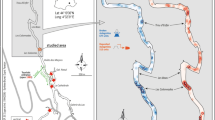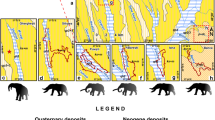Abstract
For the past 20 years the modern human origins debate has received a significant amount of attention in paleoanthropological research. Primarily supported by the evidence of earlier dates of anatomically modern human fossils and genetic studies, the “Out of Africa” hypothesis is based on the belief that the ancestor of all modern humans, including modern Chinese, came from Africa. The opposite hypothesis “Mutiregional evolution” proposes that continuous evolution occurred on a regional scale, for which human paleontology offers strong support. However, due to the paucity of hominid fossils in China between 100 and 50 ka, support to the latter hypothesis is currently weak. This is a report here of five human fossil teeth, and associated stone tools and mammal fossils from a newly discovered cave site, Huanglong Cave, located in Yunxi County, Hubei Province, China. Preliminary studies indicate: (1) the morphological features of the human fossils resemble those of late Pleistocene human fossils from China; (2) the stone tools display patterns of both the southern and northern Paleolithic cultures of China; (3) the mammal fossils represent the “Ailuropoda-Stegodon” faunal unit which lived in southern China throughout the Pleistocene. ESR and U-series dating on animal teeth and a stalagmite derived from the same layer as the human teeth indicate two possible ages: 103±1.6 ka and 44±12.5 ka. In addition to other evidence presented here, it is believed that hominid occupation of the cave was likely around 100 ka. If this age is further substantiated, Huanglong Cave will be the first late Pleistocene hominid fossil site in China where anatomically modern humans lived about 100 ka. The human fossils and other related materials from Huanglong Cave will provide important information for research on the origin of modern Chinese.
Similar content being viewed by others
References
Stringer C B. Modern human origins: progress and prospects. Phil Trans R Soc Lond B, 2002, 357(1420): 563–579
Wolpoff M H, Hawks J, Frayer D, et al. Modern human ancestry at the peripheries: A test of the replacement theory. Science, 2001, 291(5502): 293–297
White T D, Asfaw B, DeGusta D, et al. Pleistocene Homo sapiens from Middle Awash, Ethiopia. Nature, 2003, 423(6941): 742–747
Wu Xinzhi. Origin of modern humans of China viewed from cranio-dental characteristics of late Homo sapiens in China. Acta Anthropol Sini (in Chinese), 1998, 17(4): 276–282
McDougall I, Brown F H, Fleagle J G. Stratigraphic placement and age of modern humans from Kibish, Ethiopia. Nature, 2005, 433(7027): 733–736
Shen Guanjun. Origin of modern humans: chronological evidence from hominid fossil localities in Southern China. Earth Sci Frontiers (in Chinese), 2004, 11(2): 543–548
Shen G, Wang W, Wang Q, et al. U-Series dating of Liujiang hominid site in Guangxi, Southern China. J Human Evol, 2004, 43(6): 817–829.
Shen Guanjun, Li Jiankun, Ji Xueping. U-series dating of Zhangkou Cave in Yiliang, Yunnan Province: Evidence for human activities in China during 40–100 ka. Chin Sci Bull, 2005, 50(4): 355–359
Sheng Helin. Handbook of Fur Animals (in Chinese). Shanghai: Shanghai Dictionary Press, 1994. 1–500
Corbet G B, Hill J E. A world list of mammalian species. Brit Mus Nat Hist, London, 1980
Zhang Shuyi. Bat Record: the Discovery and Exploration of a Scientist (in Chinese). Chengdu: Sichuan Publishing Group, 2004. 1–136
Wu Xianzhu. The report on the excavation of a Paleolithic cave at Shennongjia district, Hubei Province. Acta Anthropol Sin (in Chinese), 1998, 17(2): 121–136
Wu R K, Wu X Z, Zhang S S. Early Humankind in China (in Chinese). Beijing: Science Press, 1989. 1–437
Li T, Etler D. New middle Pleistocene hominid crania from Yunnan in China. Nature, 1992, 357(6377): 404–407
Huang W, Ciochon R, Gu Y, et al. Early Homo and associated artefacts from Asia. Nature, 1995, 378(6554): 275–278
Zheng Shaohua. Jianshi Hominid Site (in Chinese). Beijing: Science Press, 2004. 1–412
Gao X, Huang W P, Xu Z Q, et al. 120–150 ka human tooth and ivory engravings from Xinglongdong Cave, Three Gorges Region, South China. Chin Sci Bull, 2004, 49(2): 175–180
Author information
Authors and Affiliations
Corresponding author
About this article
Cite this article
Wu, X., Liu, W., Gao, X. et al. Huanglong cave, a new late pleistocene hominid site in Hubei Province, China. CHINESE SCI BULL 51, 2493–2499 (2006). https://doi.org/10.1007/s11434-006-2125-x
Received:
Accepted:
Issue Date:
DOI: https://doi.org/10.1007/s11434-006-2125-x




